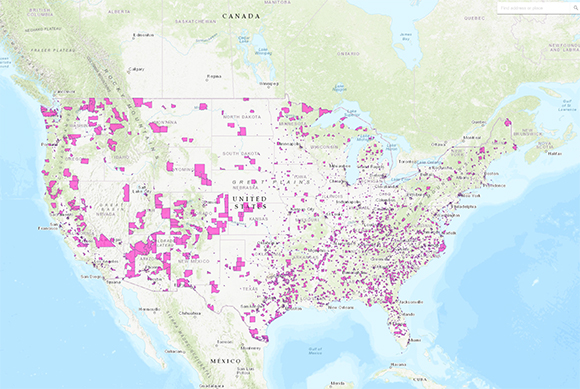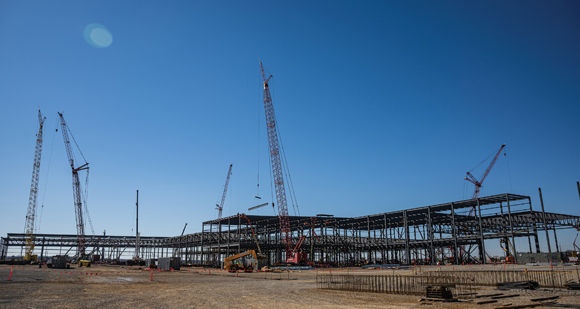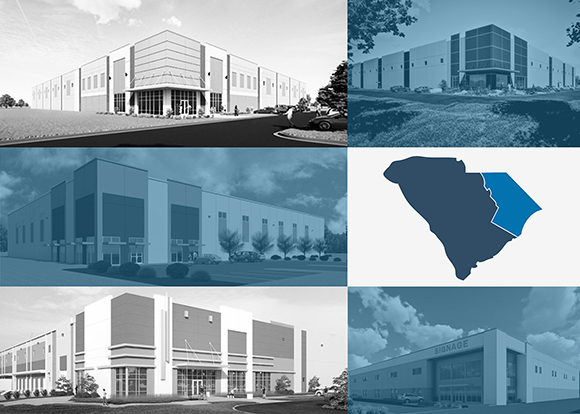|


|
FROM SITE SELECTION
MAGAZINE, MARCH 2023 ISSUE
|

|
CALIFORNIA
One credential at a time, California’s community colleges are doing
their part to raise the state’s education attainment levels and close
gaps in equity.
|
|

|
NEWS DIGEST
Quick-hitting stories update you on German FDI in the U.S.; Texas
Instruments’ $11 billion bet on Utah; reshoring to Mexico (or not); Nova
Scotia’s hydrogen hub; FlexCold’s plans in the Palmetto State; and more
billions from Tesla in Nevada.
|
|

|
GEORGIA
Read this Digital Edition account of Georgia’s blossoming relationship
with South Korean manufacturers, including the inside scoop on Hyundai’s
$5.5 billion metaplant.
|
|
 
|

|
Click here to visit this navigable and zoom-able map
of OZs across the United States developed by Esri.
Map courtesy of HUD and Esri
|
|
Two new reports are out about the Opportunity Zone program. The first,
“Examining the Latest Multi-Year Evidence on the
Scale and Effects of Opportunity Zones Investment,” comes from
Economic Innovation Group, which itself cites the findings of a paper by
U.S. Department of the Treasury economists David Coyne and Craig Johnson
titled “Use of the Opportunity Zone Tax Incentive: What the
Tax Data Tell Us” and another working paper by University of
California-Berkeley economist Harrison Wheeler, “Locally Optimal
Place-Based Policies: Evidence from Opportunity Zones,” based on
research around building permits data.
Among the findings EIG pulled from the reports:
- OZ investment reached approximately 3,800 communities from mid-2018
through 2020, representing nearly half (48%) of the total number of
designated OZ communities nationwide. By comparison, “it took 18
years for New Markets Tax Credit (NMTC) investments to reach an
equivalent number of communities,” says EIG. The Treasury paper also
points out that “over 97%of OZs are also eligible for the
NMTC-funded investment and using the 2011-2015 ACS, almost 25% of
NMTC low-income communities are also an OZ.”
- Total OZ equity investment was at least $48 billion by the end of
2020, raised from roughly 21,000 individual and 4,000 corporate OZ
investors and deployed into 7,800 Qualified Opportunity Funds.
- OZ designation caused a “large and immediate” increase in new
commercial and residential development activity such that the
likelihood of investment in a given month jumped by over 20% in
designated tracts across 47 studied cities.
- “In addition to boosting the supply of housing, OZ designations
improved local home values by 3.4% from 2017 to 2020 with no
observed increase in rents.”
The Urban Institute offers its own summary of ongoing OZ research, citing the works
above and a number of others. Novogradac released its latest summary of OZs and Qualified
Opportunity Funds activity earlier this year. And finally, Good Jobs
First maintains an ongoing web page of OZ news in its
efforts to provoke more transparency in the program. -Adam
Bruns
|
|

|
|
KENTUCKY — WHERE
TRADITION MEETS INNOVATION
|

|
ELECTRIC VEHICLE GROWTH
One secret to being green? A material known as black mass.
|
|
|
SITE SELECTION
RECOMMENDS
|

|
Among BentallGreenOak’s signature properties is 150 King West, a
28-story LEED-Platinum modernist classic in the heart of Toronto’s
financial district.
Photo courtesy of BentallGreenOak
|
|
The U.S. Environmental Protection Agency and the U.S.
Department of Energy this week announced the 220 winners of the 2023 ENERGY STAR
Awards (click on the organization name to learn full
details on their accomplishments). The honorees hail from 37
states and include organizations from Fortune 500 companies
to schools, utilities and building owners and operators.
Among the award winners are such organizations as Entergy
Texas, Electrolux, Koch Industries and Rheem Manufacturing
Company. They also include The Building Owners and
Management Association (BOMA) International and global real
estate investment management advisor and real estate
services provider BentallGreenOak (BGO), which earned the
highest level of EPA recognition (Partner of the
Year—Sustained Excellence) for the 13th consecutive year
through such measures as energy management programs that
have resulted in collective savings of 43.5 million
equivalent kWh of electricity, avoiding $6.12 million in
utility costs.
BGO achieved ENERGY STAR certification for 66 buildings
across its office, industrial and multifamily residential
portfolios. “ENERGY STAR energy benchmarking has played an
important role in informing and improving our ESG strategy
over the last 13 years,” said BGO President Amy Price. “Our
ESG approach addresses both value creation and risk
mitigation, and that navigating the challenges of climate
change, escalating energy costs, shifting regulatory
policies, and evolving tenant demands, impact the future
performance of our real estate assets. BGO believes that our
success with ESG not only benefits our communities but is an
important factor to delivering successful outcomes for our
clients.”
|
|
|
|
COLORADO – BUSINESS
COMES TO LIFE 2023
|

|
CLEANTECH
How cleantech jobs are transforming the economy of the Centennial State.
|
|

|
In response to industry needs, multiple speculative building
developments are underway in South Carolina’s northeastern region as a
result of proactive effort from various counties.
Two speculative buildings are already available, including a
100,000-sq.-ft. building in Pageland, South Carolina, and a county-owned
50,000-sq.-ft. building in Marlboro County. Construction is underway for
a 100,000-sq.-ft. speculative building along a CSX-operated rail line in
Scranton, South Carolina; a 117,000 sq.-ft. speculative building in
Florence, South Carolina; and a 99,000-sq.-ft. building in Conway, South
Carolina.
There is no doubt these buildings will not be available for long due to
soaring demand and the region’s ideal location along the East Coast,
located halfway between New York and Miami along the I-95 corridor, and
its direct access to the Port of Charleston via Inland Port Dillon.
To learn more, contact NESA at info@nesasc.org or 843-661-4669.
|
|
Indiana
Oregon-based ENTEK last week announced this megaproject in Terre Haute.
The only U.S.-owned and U.S.-based producer of “wet-process” lithium-ion
battery separator materials, ENTEK will establish operations on a
350-acre greenfield site in the Vigo County Industrial Park I, where it
plans to initially construct four buildings covering 1.4 million sq. ft.
and equipped with equipment built at current ENTEK manufacturing
facilities in Oregon and Nevada and including specialty biaxial
stretching equipment supplied by Brueckner Group USA to manufacture
battery separators for lithium-ion battery manufacturers across the
United States. “We chose Terre Haute for many reasons,” said Larry
Keith, ENTEK’s CEO, “including the excellent workforce opportunity, the
incredible support provided by Steve Witt and the Economic Development
Corporation, a nearly shovel ready construction site with available
utilities located in an industrial park, excellent vocational education,
and the business-friendly incentives from both the state and local
governments.” Watch for more from ENTEK’s team and others on how this
project came to be in the North American Automotive feature in the May 2023 issue of Site Selection.
Ontario
This week Canada’s Minister of Innovation, Science and Industry Hon.
François-Philippe Champagne announced a C$36 million contribution
through the Strategic Innovation Fund (SIF) to Ottawa-based Ranovus Inc.
to support a C$100 million project that “aims to develop the highest
performing and most power-efficient technologies for interconnect
computer chips for next-generation artificial intelligence work,” said a
federal government release. “The computing power for training artificial
intelligence systems has grown by 300,000 times over the past five
years, based on the recent OpenAI study,” said Ranovus Chairman and CEO
Hamid Arabzadeh. “To support this unprecedented growth, thousands of
computer chips must be interconnected with massive data pipes to create
an artificial intelligence cluster.” “With this contribution, Ranovus
will also increase its highly skilled workforce in Canada to 200
full-time employees and provide opportunities to 150 Canadian co-op
students,” the government stated. “This contribution is part of the
Government of Canada’s intellectual property (IP) rich initiative,
ensuring that innovative, IP-rich firms are grown into world leaders.
This will help accelerate Ranovus’s development of IP in Canada, as this
project is expected to produce 40 new patents.” In February 2022, the
Government of Canada launched the Semiconductor Challenge Callout, a
$150 million allocation from SIF to bolster the development and
manufacturing of semiconductors in Canada.
|
|

|
Site Selection Executive Vice President Ron Starner made this photo
along the St. Johns River in Palatka, Florida, yesterday as he visits to
deliver remarks today to the Putnam County Economic Development Council.
Among the redevelopment projects being pursued by the City of Palatka is
the St. Johns River Wetlands Center, a joint effort between the city and
Georgia-Pacific’s Palatka Pulp and Paper Operations that will focus on
the wetlands areas associated with the St. Johns River system. In
addition to its quality of life advantages, among Putnam County’s assets
are its three
Opportunity Zones.
|
| |

